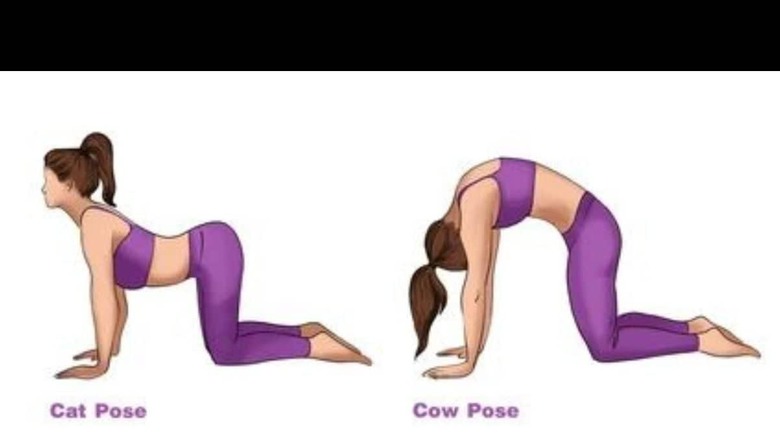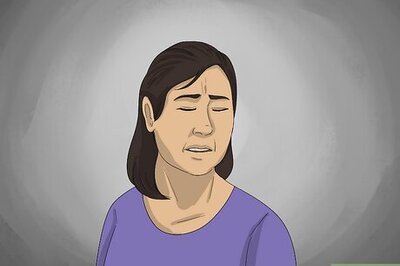
views
This exercise is also incredibly helpful for those of us with desk jobs, with frequent complaints of aches and stiffness in the shoulders and back. If you’ve seen a cat stretching after a nap, the graceful movement of the back arching up and then going concave, chances are you have felt a vicarious satisfaction. This practice does just that for humans.
The basics are about going down on all fours, arching the back up and then down, and coordinating this movement with breathing. The pose gives a feeling of stability while being dynamic: the feet, the knees, and the palms firmly on the ground with the fingers stretched out, are all proportionately apart, providing a sense of stability and ease. The coordinated breathing plays the key role, and hence the name Tiger Breathing. ‘Vyaghraha Pranayama’ and ‘Cat-Cow pose’ are the other names this practice is known by.
In Yoga as therapy, this pose is often used for people with respiratory, neurological and cardiac ailments, and also for mild depression.*
EASE AND PEACE IN THE MOVEMENT
As you arch the spine up, soak in the comfort felt in the shoulder blades and the middle back; feel elation and freedom as you raise the head and chin, and the simultaneous pressure on the lower back caused by the depression of the spine. The movement of the breath smoothly coordinates with the movement of the middle body, and the swinging sensation is mildly meditative. Close your eyes for maximum benefit.
Flexing and arching the spine exercises and relaxes the back and eases pain. The flexibility of the back and shoulders is increased. Core muscles get strengthened over time.
STRENGTHENS THE RESPIRATORY SYSTEM
The conscious breathing occurs with expansion of the chest area, such that all lobes of the lungs are used and all muscles of the respiratory system are exercised and strengthened. This way, oxygen intake and energy are optimised and channelled properly.
This exercise also helps the respiratory system by stoking and strengthening digestion. Improved digestion helps suppress Kapha Dosha — the elemental energy in the body whose imbalance causes mucous and phlegm-related illness — an Ayurveda doctor informs us. Since Kapha dosha is aggravated in cold weather, this exercise is beneficial as it can control the dosha and thus, prevent full-fledged respiratory disorders in two ways: directly, through strengthening the lungs, and indirectly through aiding digestion.
(To refresh memory: Doshas are simply the different energies within us, governed by the five elements in Nature. They are the constitutional make-up of a person and imbalance in the doshas shows up as disease. Balance is restored through pacifying that dosha with things with the opposite effect in food, lifestyle, routines, environment, stimulus, exercise etc.)
ACTS ON THE VAGUS NERVE, RELIEVES ANXIETY, IMPROVES DIGESTION
Prana or energy enters through deep breathing and the nerves are stimulated. Movements also increase circulation in the spinal area, neck and head. The Vagus nerve extends from the brain to the abdomen and has a direct connection with the parasympathetic nervous system. As the parasympathetic nervous system gets activated, it relaxes the mind.
The contraction and release of the abdomen massages the abdomen and organs in that area, which also helps release stress. Digestive organs get exercised and digestion improves.
ENERGISES THE BODY AND HELPS IN MILD DEPRESSION
Being a breathing exercise, it has the effect of relaxing the body and mind. It takes in and distributes oxygen to body parts. Prana enters the system and into the spine and nerves.
Blood circulation also improves in the head, spinal area, back, chest and abdomen and stimulates them.
The engagement of the body from the core to the head, done along with breathing, helps the body-breath-mind connection and awareness. Regular practise relieves anxiety and mild depression gradually.
Follow this with Savasana, which progressively relaxes each body part from the tip of the toes to the top of the head, for full and complete relaxation at every level.
TIGER BREATHING: THE STEPS
• Sit in Vajrasana, keeping a 12-inch gap between knees. Kneel and come on to all fours.
• The back now resembles a table-top, the palms are placed just below the shoulders with fingers spread out, and the knees just below the hips.
• Inhaling, raise the neck and head, while depressing the spine.
• Exhaling, lower the head, bringing the chin near the chest, while arching the back up.
• Remember to keep the movements and the breathing slow, smooth, and coordinated.
• Repeat this 10 times or as per your capacity.
• To close, while exhaling, sit back on the heels, lower the chest on the thighs, arms still stretched in front, and place the forehead on the floor. Relax with normal breathing.
• For complete relaxation, turn on your back, take a deep breath and relax and proceed to do Savasana.
(Note: In case of neck and back trouble and knee pain, proceed with caution)
*Always remember to check with your physician before trying a new practice. Also, the above description is meant to be indicative; these practices are better first learned from a Yoga teacher.
The author is a journalist, cancer survivor and certified yoga teacher. She can be reached at [email protected].



















Comments
0 comment